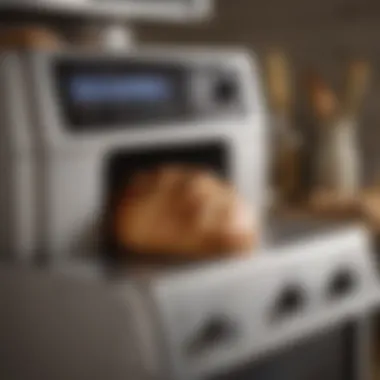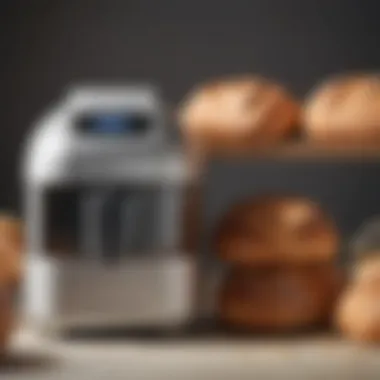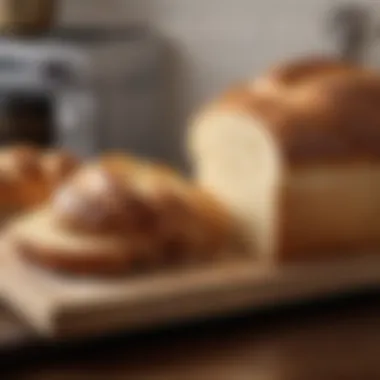A Comprehensive Guide to Buying a Bread Machine


Intro
In recent years, home baking has gained popularity, spurring interest in various kitchen appliances designed to simplify the process. One such appliance is the bread machine. These devices allow both novice and experienced bakers to create fresh, homemade bread with minimal effort. However, navigating the market for bread machines can be overwhelming due to the variety of options available. This guide aims to equip you with the essential information needed to make an informed purchase.
Understanding the nuances of different types of bread machines, their unique features, and ongoing costs can significantly impact your baking experience. From selecting the appropriate machine to mastering its use, each step holds importance in developing your skills as a home baker.
In the sections that follow, we will delve into various aspects of bread machines. We will explore types, key features to consider, and provide maintenance tips. Furthermore, we will discuss popular brands and models, enabling you to elevate your home baking to new heights.
Understanding Bread Machines
Understanding bread machines is fundamental for anyone considering this appliance. It serves as the beginning of your journey into home baking. Bread machines simplify the process of making bread, making it accessible to those who may not have the time, skill, or inclination to knead dough by hand. Knowing what they are and how they function allows potential buyers to make decisions based on their specific needs and preferences.
What is a Bread Machine?
A bread machine is an electric appliance designed to automate the process of making bread. It combines the ingredients, kneads the dough, allows it to rise, and then bakes it. This all-in-one functionality is what attracts many home bakers. Typically, bread machines have a range of settings for different types of bread, such as whole wheat, gluten-free, or artisan.
The core components of a typical bread machine include a mixing pan, a kneading paddle, and a heating element. Users can add the flour, water, yeast, and other ingredients into the pan. After the machine is set with the desired settings, it takes care of the rest in a relatively short time, usually ranging from two to four hours, depending on the selected program. This convenience is what has led to a surge in popularity within home kitchens.
How Bread Machines Work
The operation of a bread machine can be broken down into several distinct stages:
- Mixing: Once the ingredients are added, the machine starts by mixing them together. It uses the kneading paddle to ensure all components are well combined.
- Kneading:
This stage involves the thorough kneading of dough. The machine uses its paddle to stretch and fold the dough, creating the gluten structure necessary for proper rise and texture. - Rising:
The machine then allows the dough to rise within its confines. This is controlled by the heating element, which maintains an optimal temperature for yeast fermentation. - Baking:
Finally, the machine shifts into baking mode, where the dough is cooked at a high temperature. The end result is fresh, homemade bread.
Bread machines make the baking process simple, allowing individuals to enjoy fresh bread without the effort typically involved in traditional methods.
In summary, understanding what a bread machine is and how it works is crucial for consumers. It enables them to appreciate its utility and consider its place in their daily cooking routines.
Types of Bread Machines
Understanding the types of bread machines available is crucial when considering a purchase. Each type caters to different baking preferences and kitchen space. Knowledge of these categories can greatly influence your satisfaction with the machine and the quality of bread produced.
Horizontal vs. Vertical Models
Bread machines typically come in two design options: horizontal and vertical. The choice between them depends largely on your culinary habits and available kitchen space.
Horizontal models resemble traditional ovens, producing loaves that are rectangular. They often come with features that allow for larger loaf sizes. This can be suitable for families who consume more bread regularly. These machines tend to have two kneading paddles, distributing the kneading process more efficiently and resulting in better texture. However, they do require more counter space.
On the other hand, vertical models are designed to be more compact. They produce a taller, round loaf, and usually have a single kneading paddle. These machines are ideal for smaller kitchens, providing a space-saving advantage. Although the loaf size may be smaller, this type can still efficiently bake quality bread. Vertical models often come with a more straightforward operation, making them suitable for beginners.
Here are some points to consider when choosing between horizontal and vertical models:
- Space Requirements: Horizontal machines need more countertop area than vertical ones.
- Loaf Shape and Size: Choose based on your preferred loaf shape and your family's consumption.
- Kneading Efficiency: Horizontal models generally offer better kneading due to double paddles.
Manual vs. Automatic Bread Machines
When selecting a bread machine, you may also need to decide between manual and automatic options. Each type has its own advantages and drawbacks, which can drastically affect your baking experience.
Manual bread machines require the user to input specific settings and monitor the baking process. This level of control can be beneficial for those who enjoy experimenting with various recipes and techniques. Manual models allow for more customization, which can lead to tailored results. However, this requires some prior knowledge about bread-making processes.


Automatic bread machines, conversely, facilitate a more hands-off approach. They typically come with preset programs, making them easy to use for beginners. The automatic settings streamline the process, allowing you to add ingredients and simply select the desired program. For those who wish to bake quickly with less hassle, these machines present a convenient option.
Here are certain criteria to consider when choosing between manual and automatic models:
- Control over the baking process: Manual models offer more opportunities for customization.
- Ease of use: Automatic models are designed for simplicity, appealing to novices.
- Baking Skills: Choose based on your comfort level and knowledge of bread-making.
Ultimately, the decision between horizontal and vertical models, as well as manual and automatic machines, should align with your personal baking goals and kitchen limitations. By understanding these types of bread machines, you can make an informed choice that enhances your home baking experience.
Key Features to Consider
When selecting a bread machine, understanding the key features is crucial. These components can significantly affect your baking experience, quality of the bread, and the machine's usability. Recognizing what features are most relevant to your needs is essential for making a thoughtful purchase decision.\n\n### Loaf Size Options\n\nDifferent machines offer a range of loaf sizes. Typical options include one-pound, one-and-a-half-pound, and two-pound loaves. Choosing the right size will depend on your household's needs. A one-pound loaf may suffice for a small family or a single individual, but larger families may benefit from a two-pound machine. Some models even allow for multiple loaf sizes, offering greater flexibility. This feature ensures you can make just the right amount without wasting ingredients.\n\n Programmable Settings\n\nProgrammable settings are one aspect that can elevate the ease of use of a bread machine. These settings allow you to customize the baking process according to your preferences. A good machine might offer options for different bread types such as whole wheat, gluten-free, or dough-only cycles. With a programmable timer, you can wake up to the smell of fresh bread by setting the machine to start during the night. This feature can be a real game-changer if you value fresh bread but have a busy schedule.\n\n Crust Color Selection\n\nCrust color selection is another feature that may seem trivial but can greatly enhance your baking experience. Most machines allow users to choose between light, medium, and dark crusts. This versatility caters to individual taste preferences. For instance, some may prefer a crusty exterior while others enjoy a softer finish. Being able to control the crust color can elevate the final product and match it to your meal or occasion.\n\n Delay Timer Function\n\nThe delay timer function permits you to set a start time for baking. This feature is particularly appealing for those who want to coordinate the bread with meal times. If you plan a dinner and want fresh bread to accompany it, you can set the machine to begin baking a few hours in advance. This ensures that you can enjoy warm bread right when you need it, adding a fresh element to your dining experience.\n\n Built-in Dispenser\n\nA built-in dispenser is an innovative feature that can streamline the bread-making process. Machines equipped with this function can automatically add ingredients such as nuts, fruits, or seeds at the right moment. This feature eliminates the need for manual intervention and ensures that delicate ingredients are mixed in perfectly. As a result, the quality of the final product can be enhanced, delivering an evenly distributed flavor throughout the loaf.
Price Range and Budgeting
When considering the purchase of a bread machine, understanding the price range and budgeting effectively can significantly influence your buying decision. The investment you choose to make in a bread machine should align with your baking frequency and the features you desire. Pricing can vary widely, from entry-level models that serve basic needs to premium machines with advanced functionalities. Assessing your budget is essential to ensure that you purchase a unit that meets your needs without overspending.
Understanding the Cost Spectrum
The cost of bread machines can be categorized into several tiers. Basic bread machines typically cost between $50 and $100. They come with standard features, suitable for beginners. Mid-range machines, often priced between $100 and $200, often include additional settings and better build quality. At the higher end, bread machines can exceed $200. These machines boast advanced functions such as Wi-Fi connectivity, multiple loaf sizes, and specialized settings for gluten-free or artisan bread.
Consider the following factors while analyzing the cost spectrum:
- Feature Set: Higher-priced models usually offer a wider array of functionalities.
- Durability: Spending more upfront can offer longer-lasting machines.
- Warranty: Expensive machines may come with extended warranties, providing additional peace of mind.
While it may be tempting to choose the cheapest option, consider how often you will use the machine and whether its limitations would lead to future replacements.
Evaluating Value vs. Cost
When selecting a bread machine, it's crucial to evaluate the value it offers in relation to its cost. A higher price does not always mean superior quality. It is important to assess whether the additional features justifiy the price.
Consider the following:
- User Needs: Determine what functionalities are most relevant to your baking habits.
- Build Quality: Research reviews to understand if the higher cost correlates with better materials and craftsmanship.
- Ongoing Costs: Factor in what accessories or ingredients you may need in the long run, as these can increase your overall investment.
"The best bread machine is often one that perfectly suits your needs, balancing cost with quality."
In summary, budgeting for a bread machine requires careful consideration of costs alongside value, ensuring that your choice ultimately enhances your home baking experience.
Popular Brands and Models
When venturing into the world of bread machines, understanding the landscape of popular brands and models is crucial. This knowledge not only helps in identifying quality but also in recognizing features that stand out. Bread machines can vary significantly in terms of performance, durability, and functionality. Therefore, choosing the right brand can significantly enhance your bread-making experience.
As a consumer, you want reliability and consistency. Popular brands usually have a history of consumer satisfaction and product longevity. They often provide customer support, warranty options, and readily available parts. Additionally, established brands tend to offer a wide range of models with varying features tailored to different baking needs.
Top Brands in the Market
Several brands dominate the bread machine market. Each of them has a unique approach to design and functionality.
- Zojirushi: Known for high-quality machines, Zojirushi often features dual kneading blades and a range of programmable settings. Their models generally have a reputation for making uniform bread with excellent texture.
- Panasonic: Another leading brand, Panasonic combines modern technology with ease of use. Their bread machines are known for automatic yeast dispensers and can produce various types of bread including gluten-free.
- Cuisinart: This brand offers versatility in its models. Cuisinart machines typically have multiple settings for different types of bread and are user-friendly, appealing to both novices and experienced bakers.
- Breville: Known for their innovative features, Breville machines offer unique options like automatic fruit and nut dispensers. Their models are often praised for design and additional options for crust settings.
- Hamilton Beach: A more budget-friendly option, Hamilton Beach provides solid performance without the high price tag. Their machines are straightforward and reliable, making them suitable for casual bakers.


With these brands, you're more likely to find models that suit your specific needs and preferences.
Comparative Analysis of Models
When evaluating bread machines, it's essential to analyze specific models within these brands. Here's a look at some key factors to consider:
- Capacity: Different models offer varying loaf sizes, typically ranging from one pound to two and a half pounds. Ensure the model meets your household’s consumption.
- Settings and Programs: Investigate the number of pre-set programs. More options mean flexibility in baking different types of bread, such as whole grain or artisan.
- Ease of Use: Consider what users say about the interface. Models with intuitive controls and straightforward display settings can simplify the bread-making process.
- Reviews and Performance Ratings: Look for consumer ratings and feedback. Often, personal experiences reveal insights about durability and operational excellence that spec sheets may not cover.
"Understanding the distinctions among models can lead to better choices when selecting your ideal bread machine."
User Reviews and Ratings
When it comes to investing in a bread machine, user reviews and ratings serve as a critical resource for potential buyers. While marketing materials showcase features and benefits, actual consumer experiences provide a more grounded perspective. These reviews can illuminate aspects that promotional content might overlook, offering invaluable insights on reliability, ease of use, and overall satisfaction.
User feedback often includes practical observations about specific models, reflecting real-world performance over theoretical specifications. Through reviews, buyers learn about the durability of a machine, its effectiveness in making different types of bread, and any drawbacks that may not be immediately apparent. Overall, user reviews can help demystify the purchasing process, making it easier for consumers to make choices aligned with their needs and preferences.
Importance of Consumer Feedback
Consumer feedback is paramount in today’s shopping landscape. For those considering the purchase of a bread machine, reviews act as a reality check. They provide anecdotal evidence that contributes to understanding how various models perform under different circumstances.
One of the benefits of reading through user experiences is the ability to gauge the consistency of products. A machine may claim to produce perfect loaves, but reviews can reveal whether this is consistently achievable across various recipes and user scenarios. Additionally, consumer feedback helps identify any common issues that a product may have, allowing potential buyers to weigh these issues against their own priorities.
Moreover, feedback from regular users often dives into the subtleties of use—such as programming intricacies, cleaning ease, and storage considerations—providing a clearer picture of day-to-day operations and enjoyment.
Evaluating Reviews for Better Decisions
Evaluating user reviews effectively requires a discerning approach. Not all reviews are created equal, and understanding how to interpret feedback will lead to more informed choices.
When sifting through reviews, consider the following:
- Quantity and Recency: A higher volume of reviews can indicate reliability. Consider recent feedback to reflect current model performance, as manufacturers may have made improvements or fixed issues.
- Overall Sentiment: Look for patterns. If a majority of reviews are highly positive, it suggests strong performance. Conversely, recurring negative themes could signal concerns worth noting.
- Specific Details: Reads reviews that discuss specific features of the bread machine. For instance, comments on crust color options or the effectiveness of the delay timer can provide better insight into whether these features will meet your expectations.
Additionally, contrasting reviews from various platforms can offer a broader understanding. For example, a review on Reddit may discuss community perspectives, while reviews on ecommerce sites often emphasize product performance and support experiences.
Maintenance and Care Tips
Maintaining your bread machine is crucial for ensuring its longevity and optimal performance. Without proper care, even the best machines can experience wear and tear, leading to inefficient baking or complete operational failure. Regular maintenance not only extends the life of the appliance but also enhances the quality of the bread produced. This section discusses daily practices and long-term strategies for preserving your bread machine, enabling you to enjoy freshly made loaves for years to come.
Daily Maintenance Practices
Daily maintenance for your bread machine revolves around keeping it clean and well-maintained. After each use, it's essential to follow specific steps:
- Clean the Bread Pan: Remove the bread pan and wash it with warm soapy water. Ensure to avoid using abrasive sponges, as they may scratch the surface. Thoroughly rinse and dry the pan before placing it back.
- Wipe the Machine Interior: Use a damp cloth to wipe the interior of the bread machine. Pay special attention to the kneading blade and any crevices where flour may accumulate.
- Check the Kneading Blade: Inspect the kneading blade for any stuck ingredients. If necessary, remove it and clean it with warm water.
- Inspect Gaskets and Seals: Look at the rubber gaskets to ensure they are in good condition. Proper sealing is essential for maintaining the ideal baking environment.
Adopting these practices can significantly improve the performance of your bread machine and the quality of the breads produced.
Long-term Care Strategies
Long-term care strategies involve more than just daily cleaning. These practices aim to ensure that your bread machine remains functional over time:


- Regular Inspection: Check the power cord for any signs of damage. If the cord is frayed, consider replacing it to prevent safety hazards.
- Store Properly: If you don't use your bread machine regularly, store it in a cool, dry area. Cover it to avoid dust accumulation. Weather and humidity can cause unseen damage if it’s stored improperly.
- Avoid Overcrowding: Do not overload the bread machine with ingredients. Follow recommended measurements for flour, water, and other ingredients to prevent strain on the motor.
- User Manual Review: Regularly revisit the user manual for specific care recommendations or suggested maintenance schedules provided by the manufacturer.
"A well-maintained bread machine not only serves its purpose but also enriches your baking experience."
Implementing these long-term care strategies allows your machine to function optimally and helps maintain the joy of fresh bread baking.
Baking Techniques and Best Practices
Baking bread is an art, and a bread machine can simplify this process significantly. However, to truly maximize the benefits of using a bread machine, understanding specific baking techniques and best practices is essential. This section will equip you with practical insights to elevate your baking experience.
Experimenting with Recipes
Bread machines offer a remarkable opportunity to experiment with a variety of recipes. Home bakers can go beyond standard white or whole wheat bread and try sourdough, gluten-free options, and even specialty breads like focaccia. The flexibility of a bread machine allows for this variation without the intensive labor often associated with bread making.
When experimenting, start with basic recipes adapted to your machine. Mixing different flours can change the texture and flavor. You can also integrate herbs, nuts, or cheese for added taste. It is important to keep detailed notes of your modifications to ingredients or baking times; this will aid in refining the recipe over time.
Considerations for Recipe Experimentation:
- Follow the machine’s manual: Each bread machine may have specific requirements.
- Adjust liquid ingredients according to the flour type.
- Monitor the dough consistency throughout the process. Liquid and dry ingredient ratios can affect the final product immensely.
Understanding Ingredient Ratios
Another fundamental aspect of successful bread making is understanding ingredient ratios. The balance between flour, water, yeast, and salt plays a critical role in determining the outcome of any bread. Standard recipes often follow a baseline ratio that can be modified:
- Flour: Usually the primary ingredient, should make up around 60-70% of the total weight of the final dough.
- Water: Typically, should be about 55-65% of the flour weight to achieve the correct hydration.
- Yeast: Depending on the type used, fresh yeast is generally at 1-2% of the flour weight, while dry yeast can be slightly less.
- Salt: Essential for flavor and controlling yeast activity, it should be about 1.5-2% of the flour weight.
Understanding these ratios enables you to create a variety of bread types while ensuring quality and taste. Adjust proportions to create softer or denser breads depending on your preference.
By mastering these practices, you can make better use of your bread machine, leading to consistently high-quality loaves. Nestled within the art of combining ingredients lies the key to not just baking, but to enjoying the entire process.
The Future of Bread Machines
The future of bread machines is an important topic in this article as it delves into evolving trends that shape home baking. These machines have come a long way and are adapting to contemporary consumer needs for convenience, efficiency, and sustainability. The consumer landscape is shifting. Bread enthusiasts are increasingly looking for machines that meld innovation with simplicity while aligning with values around sustainability and health.
Innovations in Home Baking Technology
Home baking technology is witnessing significant advancements. The modern bread machine not only bakes bread; it now integrates multiple functionalities. Many machines now come equipped with smart technology that connects with smartphones. Users can customize programs and control their machines remotely. This allows for personalized baking experiences, catering to individual tastes and dietary requirements.
Another major leap is in the development of rapid baking cycles. Traditional baking often requires several hours. New models can reduce this time significantly without compromising the quality of the bread output. This is appealing to those who value speed without sacrifice. Moreover, improved heating elements and sensors enhance baking consistency. Some machines even self-adjust based on humidity and temperature, ensuring perfect results.
Things such as built-in weighing scales and recipe libraries increase the usability of these devices. This feature allows bakers to weigh ingredients accurately and even get step-by-step guidance, making the baking experience less intimidating for novices.
Sustainability Trends in Baking
Sustainability is becoming central to the purchase decisions of many consumers. As awareness of environmental issues rises, home bakers are searching for bread machines that support sustainable practices. Current trends indicate a demand for energy-efficient models that minimize electricity usage. This focus is not only about the machine’s power consumption but encompasses overall product life cycle, from manufacturing to disposal.
In addition, many brands are now paying attention to the materials used in their machines. Consumers favor models made from eco-friendly components and those produced with minimal packaging.
The rise in the use of organic ingredients in baking is another crucial trend. Bread machines designed to work effectively with organic grains and flours are gaining traction.
The integration of sustainability practices illustrates a shift in consumer priorities. As people become more conscious of their choices, the demand for innovative, eco-friendly bread machines will likely expand. Additionally, this trend aligns with a broader commitment to health and wellness in food choices.
"As the market evolves, so do the expectations of consumers. Bread machines need to keep pace with these changes to remain relevant."
Understanding these innovations and trends provides insight into how bread machines are expected to evolve in the coming years. With increasing capabilities and a strong emphasis on sustainability, consumers are poised to enjoy an enhanced baking experience.















